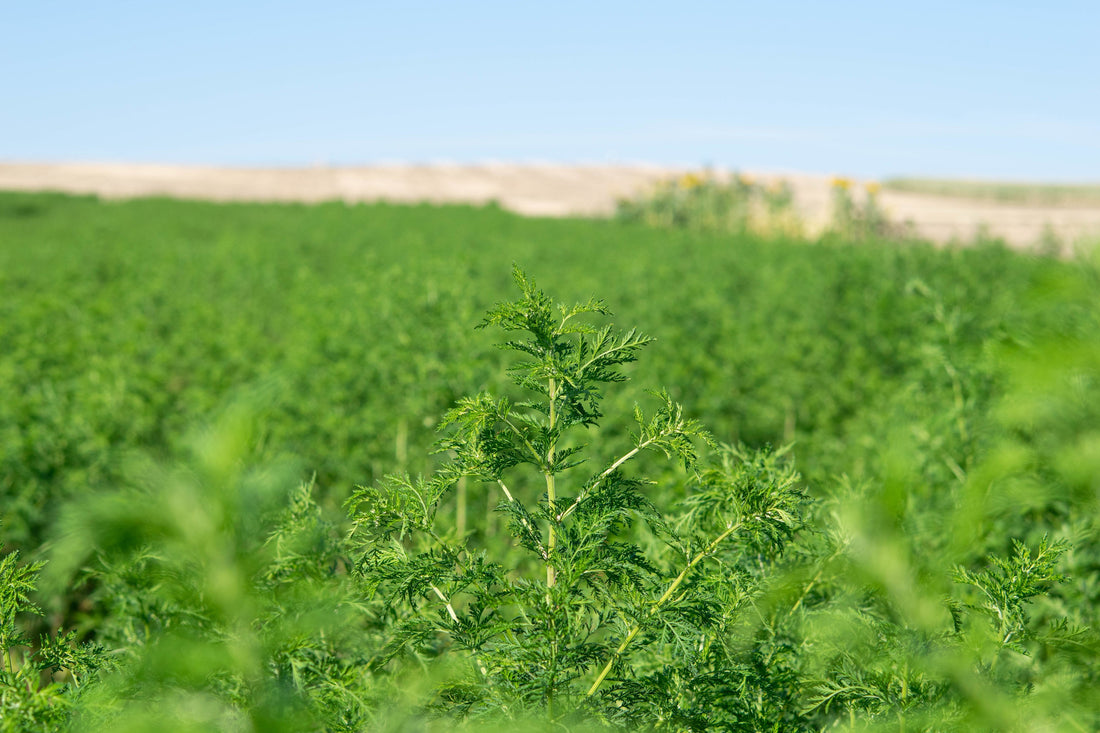For a long time, the annual mugwort, or Artemisia annua, received little attention in Germany and Europe. Nevertheless, the medicinal herb, which is known for its numerous ingredients, has been gaining popularity in Europe for some time. Find out more about this special Artemisia annua plant, its origin and where you can buy it.
1. annual mugwort: meaning and history
The plant "annual mugwort" with the botanical name "Artemisia annua" is a species of mugwort and medicinal plant from the composite family that has been used for over 2000 years, especially in Asia. The Latin name of the plant is Artemisia annua, which is a combination of the name of the Greek goddess of hunting and woods, Artemis, and the Latin term annus, meaning "year". Another theory is that the great Persian queen Artemisia once gave the plant its name. Both possibilities reveal the high status that mugwort plants generally had at that time. Unlike in our country, Artemisia was one of the most important medicinal plants for the Persians, the ancient Greeks and the Romans.
In ancient Rome, mugwort, as "Diana herb", was also named after a goddess, and was highly regarded above all for its healing properties. The Romans, it is said, used Artemisia as a remedy with effectiveness against various women's ailments, such as menstrual cramps. But apart from its effect and application against various diseases, Artemisia was already known in the 1st century AD as a rather mystical plant, which was afflicted with all kinds of superstitions. For example, it was believed that Artemisia, in addition to its healing power, also increased endurance, speed and performance when running. Another legend claims that mugwort was grown along Roman roads so that legionaries could put it in their shoes to treat aching feet.
But the story of the mugwort Artemisia was far from over. During the First World War, mugwort was used in military hospitals to suppress the spread of disease.
Then, in the middle of the 20th century, the special mugwort species Artemisia annua was used during the Vietnam War. During this time, numerous soldiers fell ill and died of malaria. Artemisinin was isolated from Artemisia annua as an antidote against the disease, which could not be controlled, and thus one of the most effective substances against malaria was identified.
2. annual mugwort: origin
The annual mugwort (Artemisia annua) originally comes from Asia. China, Vietnam and northern India are considered to be the home of the mugwort. Its natural habitat is sandy riverbanks, lakeshores and wadis (valleys/gorges) in the temperate climate zones of Asia. However, annual mugwort is also becoming more and more socially acceptable in Africa and South America and is spreading rapidly, mainly because of its medicinal properties. Although rare, it can now also be found in Europe. Since the plant Artemisia annua does not tolerate frost, however, it must be grown in Germany and similar regions in the warm during the cold season.
3. annual mugwort: differences to "common/ordinary" mugwort
A relative of annual mugwort is the "common/ordinary" mugwort native to Europe, also known as "Artemisia vulgaris" or "spice mugwort". It grows wild in Germany on many roadsides and forest edges, scree areas or often in the home garden. However, the plants differ in appearance, effect and possible uses.
Common mugwort is mainly used as a kitchen spice and is a must in most European households for the traditional roast goose. It has dark leaves and inconspicuous flowers. The annual mugwort (Artemisia annua), on the other hand, is very rarely found in the wild in this country. It has lush green leaves about 3 to 5 cm long and rarely flowers. It also has a strong balsamic scent of camphor, thyme or mint.

4. annual mugwort: use in traditional Chinese medicine (TCM)
As already mentioned, annual mugwort finds its origin in China, among other places. For this reason, Artemisia annua is also an integral part of traditional Chinese medicine (TCM) and has been used there for many centuries as a medicinal plant to alleviate malaria, recurrent fever, fungal infections, parasites or to strengthen the immune system.
5. annual mugwort: artemisinin
The plant Artemisia annua has many uses and is known for numerous active substances that are said to have anti-inflammatory, antiviral, antibacterial and immune system-strengthening effects. In addition to amino acids, iron, manganese, calcium or zinc, annual mugwort also contains many other ingredients such as essential oils, antioxidants and bitter substances. Of particular interest, however, is the main active ingredient artemisinin, which is particularly abundant in this plant.
The artemisinin content of annual mugwort is 10-20 times higher than in the wild form Artemisia vulgaris. This active ingredient has so far only been found in Artemisia annua and is mainly used against malaria.
A groundbreaking study on the successful treatment of malaria with the active ingredient artemisinin was published in the 1970s by the Chinese scientist Tu Youyou. Her discovery was awarded the Nobel Prize in Medicine in 2015. Since then, the active ingredient has been successfully isolated from the plant and used against malaria (see aerzteblatt.de Nobel Prize in Medicine for the discovery of avermectin and artemisinin from 5 October 2015). Artemisinin is still being intensively researched today. Among other things, with the aim of gaining positive insights into the treatment of AIDS and cancer.
Artemisinin is mainly found in the leaves of the mugwort Artemisia annua. This is contained in a particularly high concentration in the plant shortly before flowering.
In addition to the active ingredient artemisinin, the high Oxygen-Radical-Absorbance-Capacity value (ORAC) of the plant is also positive. This describes the extent to which free radicals can be captured, thus causing an antioxidant effect. This can be a decisive criterion especially in studies on the treatment of degenerative diseases such as arthrosis or rheumatism.
6. annual mugwort: cultivation
Annual mugwort is cultivated in fields in our region. As soon as the herbaceous plant has reached a height of 10-15 cm, it can be planted outdoors. However, only under the condition that no more frost is to be expected. A bright location and a good water supply is also very important for the so-called "light germinators". The medicinal plant needs a lot of light and warmth and prefers calcareous soil. 
It is therefore important when sowing the mugwort plant that the seeds not only get enough light, but are also only covered by a light layer of soil. If the plant is later "potted out", the annual mugwort needs enough space to develop. For this reason, we make sure that the mugwort is not planted too close together. The individual plants should be at least 60-80 cm apart.
Due to the high water requirements of the young plants, we water them sufficiently if necessary. Only when the plant, which will grow to 1-2 metres high in the course of time, is large enough and has formed a stable root system, will regular watering of the mugwort be discontinued.
7. annual mugwort: harvest
Harvesting takes place from about July to the end of October, shortly before flowering. Harvesting is done exclusively by hand to sort out any yellow and brown leaves. The harvested herb is relatively easily stripped from the stem.
Then comes the more difficult part, the further processing. In order to really preserve all the ingredients, the Artemisia leaves have to be dried gently under optimal temperatures. As an agricultural company, we use specially designed drying equipment for this purpose. It is important that the leaves are processed neither too moist nor too dry in order to guarantee optimal development of the active ingredients as well as shelf life.
We refrain from sowing the seeds in October, as they usually mix with the low-potency seeds of the fast-flowering wild form.
Information on cultivation and harvesting can be found here.
What to look for when buying?
If you want to buy Artemisia annua products, you have to pay attention to the quality. The herb should arrive juicy green and stem-free and not brown or with many "wooden" stems. It should also not smell "musty". This could be an indication of mould. Dried annual mugwort has a strong essential scent of camphor, thyme or mint. The scent is aromatic, soothing and lasts a long time.
You can find more tips on buying annual mugwort in our blog post "Buying Artemisia - What to look out for".
Buy Artemisia-annua in our shop!
Are you interested in the Artemisia annua plant?
Then secure it for yourself in dried form and optimally processed. Click on the button "Products" in the upper bar!
We wish you all the best,
Your Artemisia Shop Team

